| Name | Bone File #33 |
| Lead Time | 0-3 days |
| Specialty | Neuro, Ortho & Spine-Rasps & Files |
| Material Finish | Stainless Steel |
| Grade | Premium Operating Room |
| Units of Measurement | Each |
| Manufacturer | Lexis Industry |
| Sterility | Non-Sterile |
| Usage | Reusable |
Bone File #33
double-ended, plain serrations, 6.0 mm & 5.0 mm wide ends, 7″ (17.5 cm)?Bone File #33 is ideally suit for use in neurosurgical and orthopedic surgeries that require manipulation of bone in and around delicate tissue structures. This type of instrument can be useful in filing down the skull in procedures like craniotomies or in reshaping the vertebral arch during laminectomies or hemi-laminectomies. This gives added protection to the brain tissue or neurovascular bundles that can pass over these cut surfaces that may be jagged and could cause additionally injury or trauma. Additionally this file is double ended with plain serrations and features a 6.0 mm and 5.0 mm wide ends.
28
People watching this product now!
SKU:
EI-01-1233
Category: Rasps & Files
Description
Reviews (0)
Be the first to review “Bone File #33” Cancel reply
Related products
Bone File #12
double-ended, plain serrations, 7.0 mm & 5.0 mm wide ends, 7" (17.5 cm)?Bone File #12 can be used in a variety of surgical interventions in neurosurgery or orthopedic surgery. This instrument is double ended with each end featuring plain serrations. It is ideally suited for use in filing bones such as reducing a sharp or jagged bone edge to prevent damage to surround tissue or delicate neuro-vascular bundles. Additionally each even here is a different width: 7.0 mm and 5.0 mm making it versatile enough to be used in a number of different surgical scenarios and can satisfy any surgeon preference.
Bone File #92A
single-ended, 2.0 mm wide, file outside, backward cutting, angled w/ serrations, 6" (15.0 cm)?Bone File is a highly versatile instrument that can be used in almost any neurosurgical orthopedic procedures. Ranging from craniotomies to spinal surgery this file can be used to file down any types of bone. This can be useful in smoothing down rough edges to prevent catching or tearing of delicate tissues or vasculature during surgical intervention. This instrument is single-ended with the file outside and is angled with serrations and can be used in backward cutting.
Bone File #10
double-ended, plain serrations, 5.0 mm wide ends, 7" (17.5 cm)?Bone File #10 is a general purpose instrument useful in surgical procedures that require manipulation of bone. This file is double ended making it quick and easy to switch to another unused file without having to switch instrumentation. Each end features plain serrations and is 5.0 mm wide. Additionally this instrument features a slightly textured handle surface that reduces slippage making this instrument ideally suited for a variety of precise neurosurgical procedures.
Bone File #92B
single-ended, 2.0 mm wide, file inside, backward cutting, angled w/ serrations, 6" (15.0 cm)?Bone File is a highly versatile instrument that can be used in almost any neurosurgical orthopedic procedures. Ranging from craniotomies to spinal surgery this file can be used to file down any types of bone. This can be useful in smoothing down rough edges to prevent catching or tearing of delicate tissues or vasculature during surgical intervention. This instrument is single-ended with the file inside and is angled with serrations and can be used in backward cutting.
Bone & Skin Rasp
5-1/8" (13.0 cm)?Bone and Skin Rasp is a unique instrument ideal for use in surgical procedures that require manipulation of bone and other hard tissue surfaces. This rasp features a long, slim handle from which extends a spatula like protrusion that has an alternating pattern of dots on it that makes this surface suited for slight filing. Not as abrasive as a file this rasp can be used for the mild reshaping of bone or more delicate semi-solid tissue layers such as bone to prevent sharp edges from causing damage to other adjacent tissue or vasculature.
Bone File #45
double-ended, plain serrations, 6.0 mm & 5.0 mm wide ends, 7" (17.5 cm)?Bone File #45 is an instrument crafted for use in neurosurgical orthopedic procedures. It features a hexagonal body that also serves as a grip that makes it easy to handle manually. This file is double ended and features plain serrations as well as two different sized ends: 6.0 mm and 5.0 mm. This instrument can be useful in surgical procedures that require filing or reshaping of bone particularly to prevent damage to surround tissue. Ideally it can be used to protect delicate brain tissue and neurovascular bundles from sharp jagged edges from breaks or from cuts made in surgery.
Miller-Colburn File
double-ended, down-cutting teeth, medium & large ends, octagonal handle, 7-1/4" (18.4 cm)?Miller-Colburn File can be used to soften jagged edges or rough surfaces on bone or other hard surfaces. This file features a slim, octagonal body shaft that doubles as a handle from which two different sizes blade extend on either side. Both ends features down-cutting teeth that allow it to grab hold and uniformly file away at a surface such as the skull or vertebral fragment to protect surrounding tissue from damage in craniotomies or spinal surgeries.
Nail & Bone Rasp
double ended, backwards cutting, 6-3/4" (17.1 cm)?Nail and Bone Rasp is ideal for a number of different neurosurgical orthopedic type surgeries. This rasp is double ended making it a two in one and can quickly switch between thw two heads. It has the ability to be backwards cutting. This instrument features serrations that allow either end to be used to whittle down or smooth roughened surfaces. In craniotomies or spinal surgeries such jagged edges can cause tearing on delicate tissue such as brain tissue or individual nerves and vasculature.

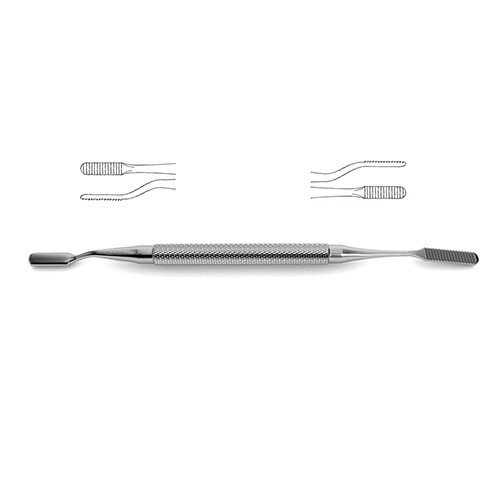

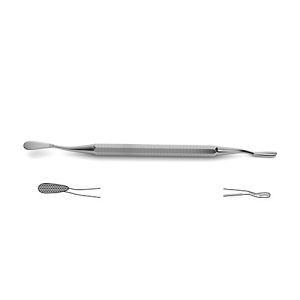
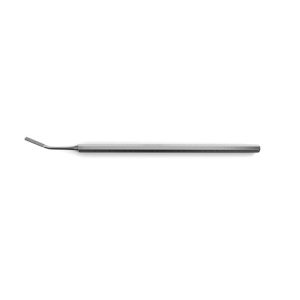
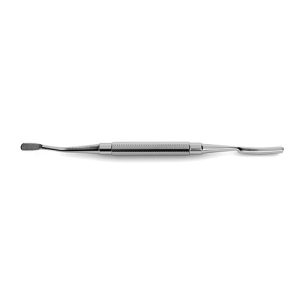
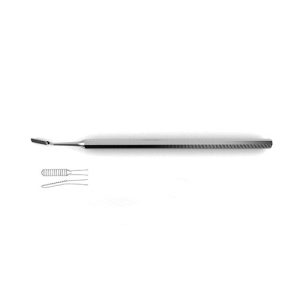
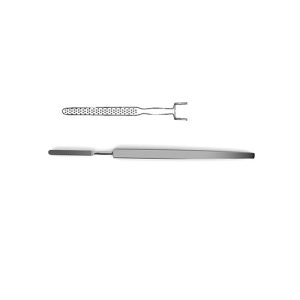
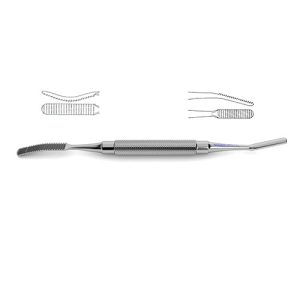

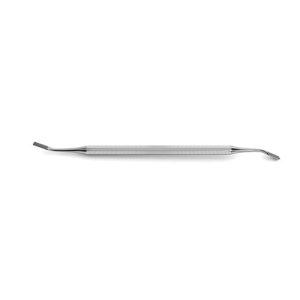


Reviews
There are no reviews yet.